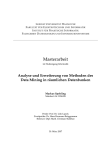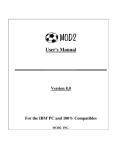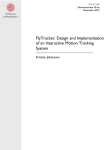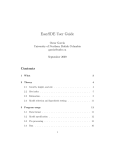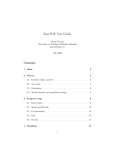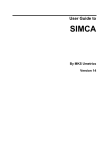Download MODEL II REGRESSION USER'S GUIDE, R EDITION
Transcript
MODEL II REGRESSION USER’S GUIDE, R EDITION PIERRE LEGENDRE Contents 1. Recommendations on the use of model II regression methods 2. Ranged major axis regression 3. Input file 4. Output file 5. Examples 5.1. Surgical unit data 5.2. Eagle rays and Macomona bivalves 5.3. Cabezon spawning 5.4. Highly correlated random variables 5.5. Uncorrelated random variables References 2 4 5 5 6 6 7 10 11 12 14 Function lmodel2 computes model II simple linear regression using the following methods: major axis (MA), standard major axis (SMA), ordinary least squares (OLS), and ranged major axis (RMA). Information about these methods is available, for instance, in section 10.3.2 of Legendre and Legendre (1998) and in sections 14.13 and 15.7 of Sokal and Rohlf (1995)1. Parametric 95% confidence intervals are computed for the slope and intercept parameters. A permutation test is available to determine the significance of the slopes of MA, OLS and RMA and also for the correlation coefficient. This function represents an evolution of a Fortran program written in 2000 and 2001. Bartlett’s three-group model II regression method, described by the above mentioned authors, is not computed by the program because it suffers several drawbacks. Its main handicap is that the regression lines are not the same depending on whether the grouping (into three groups) is made based on x or y. The regression line is not guaranteed to pass through the centroid of the scatter of points and the slope estimator is not symmetric, i.e. the slope of the regression y = f (x) is not the reciprocal of the slope of the regression x = f (y). Model II regression should be used when the two variables in the regression equation are random, i.e. not controlled by the researcher. Model I regression using least squares underestimates the slope of the linear relationship between the variables when they both contain error; see example in chapter 5.4 (p. 11). Detailed recommendations follow. Date: Id: mod2user.Rnw 593 2008-11-24 19:14:59Z jarioksa . 1 In Sokal and Rohlf (Biometry, 2nd edition, 1981: 551), the numerical result for MA regression for the example data set is wrong. The mistake has been corrected in the 1995 edition. 1 2 PIERRE LEGENDRE Table 1. Application of the model II regression methods. The numbers in the left-hand column refer to the corresponding paragraphs in the text. Par. Method Conditions of application 1 3 OLS MA Error on y error on x Distribution is bivariate normal Variables are in the same physical units or dimensionless Variance of error about the same for x and y Distribution is bivariate normal Error variance on each axis proportional to variance of corresponding variable Check scatter diagram: no outlier Correlation r is significant Distribution is not bivariate normal Relationship between x and y is linear To compute forecasted (fitted) or predicted y values (Regression equation and confidence intervals are irrelevant) To compare observations to model predictions 4 4a 4b 5 RMA SMA OLS 6 OLS 7 MA Test possible Yes Yes Yes No Yes Yes Yes 1. Recommendations on the use of model II regression methods Considering the results of simulation studies, Legendre and Legendre (1998) offer the following recommendations to ecologists who have to estimate the parameters of the functional linear relationships between variables that are random and measured with error (Table 1). (1) If the magnitude of the random variation (i.e. the error variance2) on the response variable y is much larger (i.e. more than three times) than that on the explanatory variable x, use OLS. Otherwise, proceed as follows. (2) Check whether the data are approximately bivariate normal, either by looking at a scatter diagram or by performing a formal test of significance. If not, attempt transformations to render them bivariate normal. For data that are or can be made to be reasonably bivariate normal, consider recommendations 3 and 4. If not, see recommendation 5. (3) For bivariate normal data, use major axis (MA) regression if both variables are expressed in the same physical units (untransformed variables that were originally measured in the same units) or are dimensionless (e.g. log-transformed variables), if it can reasonably be assumed that the error variances of the variables are approximately equal. When no information is available on the ratio of the error variances and there is no reason to believe that it would differ from 1, MA may be used provided that the results are interpreted with caution. MA produces unbiased slope estimates and accurate confidence intervals (Jolicoeur, 1990). MA may also be used with dimensionally heterogeneous variables when the purpose of the analysis is (1) to compare the slopes of the relationships between the same two variables measured under different conditions (e.g. at two or more sampling sites), or (2) to test the hypothesis that the major axis does not significantly differ from a value given by hypothesis (e.g. the relationship E = b1 m where, according to the famous equation of Einstein, b1 = c2 , c being the speed of light in vacuum). (4) For bivariate normal data, if MA cannot be used because the variables are not expressed in the same physical units or the error variances on the two 2 Contrary to the sample variance, the error variance on x or y cannot be estimated from the data. An estimate can only be made from knowledge of the way the variables were measured. MODEL II REGRESSION USER’S GUIDE, R EDITION 3 axes differ, two alternative methods are available to estimate the parameters of the functional linear relationship if it can reasonably be assumed that the error variance on each axis is proportional to the variance of the corresponding variable, i.e. (the error variance of y / the sample variance of y) (the error variance of x / the sample variance of x). This condition is often met with counts (e.g. number of plants or animals) or log-transformed data (McArdle, 1988). (a) Ranged major axis regression (RMA) can be used. The method is described below. Prior to RMA, one should check for the presence of outliers, using a scatter diagram of the objects. (b) Standard major axis regression (SMA) can be used. One should first test the significance of the correlation coefficient (r) to determine if the hypothesis of a relationship is supported. No SMA regression equation should be computed when this condition is not met. This remains a less-than-ideal solution since SMA slope estimates cannot be tested for significance. Confidence intervals should also be used with caution: simulations have shown that, as the slope departs from ±1, the SMA slope estimate is increasingly biased and the confidence interval includes the true value less and less often. Even when the slope is near ±1 (e.g. example §5.5), the confidence interval is too narrow if n is very small or if the correlation is weak. (5) If the distribution is not bivariate normal and the data cannot be transformed to satisfy that condition (e.g. if the distribution possesses two or several modes), one should wonder whether the slope of a regression line is really an adequate model to describe the functional relationship between the two variables. Since the distribution is not bivariate normal, there seems little reason to apply models such as MA, SMA or RMA, which primarily describe the first principal component of a bivariate normal distribution. So, (1) if the relationship is linear, OLS is recommended to estimate the parameters of the regression line. The significance of the slope should be tested by permutation, however, because the distributional assumptions of parametric testing are not satisfied. (2) If a straight line is not an appropriate model, polynomial or nonlinear regression should be considered. (6) When the purpose of the study is not to estimate the parameters of a functional relationship, but simply to forecast or predict values of y for given x’s, use OLS in all cases. OLS is the only method that minimizes the squared residuals in y. The OLS regression line itself is meaningless. Do not use the standard error and confidence bands, however, unless x is known to be free of error (Sokal and Rohlf, 1995, p. 545, Table 14.3); this warning applies in particular to the 95% confidence intervals computed for OLS by this program. (7) Observations may be compared to the predictions of a statistical or deterministic model (e.g. simulation model) in order to assess the quality of the model. If the model contains random variables measured with error, use MA for the comparison since observations and model predictions should be in the same units. If the model fits the data well, the slope is expected to be 1 and the intercept 0. A slope that significantly differs from 1 indicates a difference between observed and simulated values which is proportional to the observed values. For relative-scale variables, an intercept which significantly differs from 0 suggests the existence of a systematic difference between observations and simulations (Mespl´e et al., 1996). 4 PIERRE LEGENDRE (8) With all methods, the confidence intervals are large when n is small; they become smaller as n goes up to about 60, after which they change much more slowly. Model II regression should ideally be applied to data sets containing 60 observations or more. Some of the examples presented below have fewer observations; they are only presented for illustration. 2. Ranged major axis regression Ranged major axis regression (RMA) is described in (Legendre and Legendre, 1998, 511–512). It is computed as follows: (1) Transform the y and x variables into y 0 and x0 , respectively, whose range is 1. Two formulas are available for ranging, depending on the nature of the variables: • For variables whose variation is expressed relative to an arbitrary zero (interval-scale variables, e.g. temperature in ◦ C), the formula for ranging is: xi − xmin yi − ymin or x0i = (1) yi0 = ymax − ymin xmax − xmin • For variables whose variation is expressed relative to a true zero value (ratio-scale or relative-scale variables, e.g. species abundances, or temperature expressed in ◦ K), the recommended formula for ranging assumes a minimum value of 0; eq. 1 reduces to: yi xi yi0 = or x0i = (2) ymax xmax (2) Compute MA regression between the ranged variables y 0 and x0 . Test the significance of the slope estimate by permutation if needed. (3) Back-transform the estimated slope, as well as its confidence interval limits, to the original units by multiplying them by the ratio of the ranges: ymax − ymin b1 = b01 (3) xmax − xmin (4) Recompute the intercept b0 and its confidence interval limits, using the original centroid (¯ x, y¯) of the scatter of points and the estimates of the slope b1 and its confidence limits: b0 = y¯ − b1 x ¯ (4) The RMA slope estimator has several desirable properties when the variables x and y are not expressed in the same units or when the error variances on the two axes differ. (1) The slope estimator scales proportionally to the units of the two variables: the position of the regression line in the scatter of points remains the same irrespective of any linear change of scale of the variables. (2) The estimator is sensitive to the covariance of the variables; this is not the case for SMA. (3) Finally, and contrary to SMA, it is possible to test the hypothesis that an RMA slope estimate is equal to a stated value, in particular 0 or 1. As in MA, the test may be done either by permutation, or by comparing the confidence interval of the slope to the hypothetical value of interest. Thus, whenever MA regression cannot be used because of incommensurable units or because the error variances on the two axes differ, RMA regression can be used. There is no reason, however, to use RMA when MA is justified. Prior to RMA, one should check for the presence of outliers, using a scatter diagram of the objects. RMA should not be used in the presence of outliers because they cause important changes to the estimates of the ranges of the variables. Outliers that are not aligned fairly well with the dispersion ellipse of the objects MODEL II REGRESSION USER’S GUIDE, R EDITION 5 may have an undesirable influence on the slope estimate. The identification and treatment of outliers is discussed in (Sokal and Rohlf, 1995, Section 13.4). Outliers may, in some cases, be eliminated from the data set, or they may be subjected to a winsorizing procedure described by these authors. 3. Input file A data frame with objects in rows and variables in columns. 4. Output file The output file obtained by print.lmodel2 contains the following results: (1) The call to the function. (2) General regression statistics: number of objects (n), correlation coefficient (r), coefficient of determination (r2 ) of the OLS regression, parametric P values (2-tailed, one-tailed) for the test of the correlation coefficient and the OLS slope, angle between the two OLS regression lines, lm(y ~ x) and lm(x ~ y). (3) A table with rows corresponding to the four regression methods. Column 1 gives the method name, followed by the intercept and slope estimates, the angle between the regression line and the abscissa, and the permutational probability (one-tailed, for the tail corresponding to the sign of the slope estimate). (4) A table with rows corresponding to the four regression methods. The method name is followed by the parametric 95% confidence intervals (2.5 and 97.5 percentiles) for the intercept and slope estimates. (5) The eigenvalues of the bivariate dispersion, computed during major axis regression, and the H statistic used for computing the confidence interval of the major axis slope (notation following Sokal and Rohlf 1995). For the slopes of MA, OLS and RMA, the permutation tests are carried out using the slope estimates b themselves as the reference statistics. In OLS simple linear regression, a permutation test of significance based on the r statistic is equivalent to a permutation test based on the pivotal t-statistic associated with bOLS (Legendre and Legendre, 1998, 21). On the other hand, across the permutations, the slope estimate (bOLS ) differs from r by a constant (sy /sx ) since bOLS = rxy sy /sx , so that bOLS and r are equivalent statistics for permutation testing. As a consequence, a permutation test of bOLS is equivalent to a permutation test carried out using the pivotal t-statistic associated with bOLS . This is not the case in multiple linear regression, however, as shown by Anderson and Legendre (1999). If the objective is simply to assess the relationship between the two variables under study, one can simply compute the correlation coefficient r and test its significance. A parametric test can be used when the assumption of binormality can safely be assumed to hold, or a permutation test when it cannot. For the intercept of OLS, the confidence interval is computed using the standard formulas found in textbooks of statistics; results are identical to those of standard statistical software. No such formula, providing correct α-coverage, is known for the other three methods. In the program, the confidence intervals for the intercepts of MA, SMA and RMA are computed by projecting the bounds of the confidence intervals of the slopes onto the ordinate; this results in an underestimation of these confidence intervals. In MA or RMA regression, the bounds of the confidence interval (C.I.) of the slope may, on occasions, lie outside quadrants I and IV of the plane centred on PIERRE LEGENDRE b1 inf = 2.75 MA regr (b) bound Upper II I III IV b1 sup = −1.19 b1 = −5.67 b1 = 2.75 rb we o L nd ou CI of b1 inf = 0.84 of CI CI of nd ou rb pe n line UpA regressio M Low er b oun d of CI (a) essi on l ine 6 b1 sup = −5.67 Figure 1. (a) If a MA regression line has the lower bound of its confidence interval (C.I.) in quadrant III, this bound has a positive slope (+2.75 in example). (b) Likewise, if a MA regression line has the upper bound of its confidence interval in quadrant II, this bound has a negative slope (−5.67 in example). the centroid of the bivariate distribution. When the lower bound of the confidence interval corresponds to a line in quadrant III (Fig. 1a), it has a positive slope; the RMA regression line of example in chapter 5.5 (p. 12) provides an example of this phenomenon. Likewise, when the upper bound of the confidence interval corresponds to a line in quadrant II (Fig. 1b), it has a negative slope. In other instances, the confidence interval of the slope may occupy all 360◦ of the plane, which results in it having no bounds. The bounds are then noted 0.00000; see chapter 5.5 (p. 12). In SMA or OLS, confidence interval bounds cannot lie outside quadrants I and IV. In SMA, the regression line always lies at a +45◦ or −45◦ angle in the space of the standardized variables; the SMA slope is a back-transformation of ±45◦ to the units of the original variables. In OLS, the slope is always at an angle closer to zero than the major axis of the dispersion ellipse of the points, i.e. it always underestimates the MA slope in absolute value. 5. Examples 5.1. Surgical unit data. 5.1.1. Input data. This example compares observations to the values forecasted by a model. A hospital surgical unit wanted to forecast survival of patients undergoing a particular type of liver surgery. Four explanatory variables were measured on patients. The response variable Y was survival time, which was log10 -transformed. The data are described in detail in Section 8.2 of Neter et al. (1996) who also provide the original data sets. The data were divided in two groups of 54 patients. The first group was used to construct forecasting models whereas the second group was reserved for model validation. Several regression models were studied. One of them, which uses variables X3 = enzyme function test score and X4 = liver function test score, is used as the basis for the present example. The multiple regression equation is the following: Yˆ = 1.388778 + 0.005653X3 + 0.139015X4 MODEL II REGRESSION USER’S GUIDE, R EDITION 7 This equation was applied to the second data set (also 54 patients) to produce forecasted survival times. In the present example, these values are compared to the observed survival times. Fig. 2 shows the scatter diagram with log10 (observed survival time) in abscissa and forecasted values in ordinate. The MA regression line is shown with its 95% confidence region. The 45◦ line, which would correspond to perfect forecasting, is also shown for comparison. 5.1.2. Output file. MA, SMA and OLS equations, 95% C.I., and tests of significance, were obtained with the following R commands. The RMA method, which is optional, was not computed since MA is the only appropriate method in this example. > data(mod2ex1) > Ex1.res <- lmodel2(Predicted_by_model ~ Survival, data = mod2ex1, + nperm = 99) > Ex1.res Model II regression Call: lmodel2(formula = Predicted_by_model ~ Survival, data = mod2ex1, nperm = 99) n = 54 r = 0.8387315 r-square = 0.7034705 Parametric P-values: 2-tailed = 2.447169e-15 1-tailed = 1.223585e-15 Angle between the two OLS regression lines = 9.741174 degrees Permutation tests of OLS, MA, RMA slopes: 1-tailed, tail corresponding to sign A permutation test of r is equivalent to a permutation test of the OLS slope P-perm for SMA = NA because the SMA slope cannot be tested Regression results Method Intercept Slope 1 OLS 0.6852956 0.6576961 2 MA 0.4871990 0.7492103 3 SMA 0.4115541 0.7841557 Angle (degrees) 33.33276 36.84093 38.10197 Confidence intervals Method 2.5%-Intercept 97.5%-Intercept 1 OLS 0.4256885 0.9449028 2 MA 0.1725753 0.7633080 3 SMA 0.1349629 0.6493905 P-perm (1-tailed) 0.01 0.01 NA 2.5%-Slope 97.5%-Slope 0.5388717 0.7765204 0.6216569 0.8945561 0.6742831 0.9119318 Eigenvalues: 0.1332385 0.01090251 H statistic used for computing C.I. of MA: 0.007515993 The interesting aspect of the MA regression equation in this example is that the regression line is not parallel to the 45◦ line drawn in Fig. 2. The 45◦ line is not included in the 95% confidence interval of the MA slope, which goes from tan−1 (0.62166) = 31.87 to tan−1 (0.89456) = 41.81. The Figure shows that the forecasting equation overestimated survival below the mean and underestimated it above the mean. The OLS regression line, which is often (erroneously) used by researchers for comparisons of this type, would show an even greater discrepancy (33.3◦ angle) from the 45◦ line, compared to the MA regression line (36.8◦ angle). 5.2. Eagle rays and Macomona bivalves. 8 PIERRE LEGENDRE MA regression ● 2.6 MA regression Confidence limits 45 degree line ● ●● 2.2 ● ● ● ● ● ● ●● ●● 2.0 ● ● ● 1.8 ● ● ● ● ● ● ● ● ● ● ● ●● ● ● ● ● ● ● ● ●● ● ● ● ● ● ● ● 1.6 Figure 2. Scatter diagram of the 2.5 Example 1 data showing the major axis (MA) regression line and its 95% confidence region. The 45◦ line is drawn for reference. The cross indicates the centroid of the bivariate distribution. The MA regression line passes through this centroid. Forecasted 2.4 ●● ● ● ● ● ● 1.5 2.0 2.5 log(observed survival time 5.2.1. Input data. The following table presents observations at 20 sites from a study on predator-prey relationships (Hines et al., 1997). y is the number of bivalves (Macomona liliana) larger than 15 mm in size, found in 0.25 m2 quadrats of sediment; x is the number of sediment disturbance pits of a predator, the eagle ray (Myliobatis tenuicaudatus), found within circles of a 15 m radius around the bivalve quadrats. The variables x and y are expressed in the same physical units and are estimated with sampling error, and their distribution is approximately bivariate normal. The error variance is not the same for x and y but, since the data are animal counts, it seems reasonable to assume that the error variance along each axis is proportional to the variance of the corresponding variable. The correlation is significant: r = 0.86, p < 0.001. RMA and SMA are thus appropriate for this data set; MA and OLS are not. Fig. 3 shows the scatter diagram. The various regression lines are presented to allow their comparison. 5.2.2. Output file. MA, SMA, OLS and RMA regression equations, confidence intervals, and tests of significance, were obtained with the following R commands. That the 95% confidence intervals of the SMA and RMA intercepts do not include 0 may be due to different reasons: (1) the relationship may not be perfectly linear; (2) the C.I. of the intercepts are underestimated; (3) the predators (eagle rays) may not be attracted to sampling locations containing few prey (bivalves). > data(mod2ex2) > Ex2.res = lmodel2(Prey ~ Predators, data = mod2ex2, "relative", + "relative", 99) > Ex2.res Model II regression Call: lmodel2(formula = Prey ~ Predators, data = mod2ex2, range.y = "relative", range.x = "relative", nperm = 99) n = 20 r = 0.8600787 r-square = 0.7397354 Parametric P-values: 2-tailed = 1.161748e-06 1-tailed = 5.808741e-07 Angle between the two OLS regression lines = 5.106227 degrees Permutation tests of OLS, MA, RMA slopes: 1-tailed, tail corresponding to sign A permutation test of r is equivalent to a permutation test of the OLS slope MODEL II REGRESSION USER’S GUIDE, R EDITION ● ● 60 70 OLS MA SMA RMA ● ● 50 ● ● ● ● ● 30 ● ● 40 Bivalves (prey) ● ● ● ● ● ● 20 ● ● ● 5 10 9 15 Eagle rays (predators) Figure 3. Scatter diagram of the Example 2 data (number of bivalves as a function of the number of eagle rays) showing the major axis (MA), standard major axis (SMA), ordinary 50 leastsquares (OLS) and ranged major axis (RMA) regression lines. SMA and RMA are the appropriate regression lines in this example. The cross indicates the centroid of the bivariate distribution. The four regression lines pass through this centroid. P-perm for SMA = NA because the SMA slope cannot be tested Regression results Method Intercept 1 OLS 20.02675 2 MA 13.05968 3 SMA 16.45205 4 RMA 17.25651 Slope 2.631527 3.465907 3.059635 2.963292 Angle (degrees) 69.19283 73.90584 71.90073 71.35239 Confidence intervals Method 2.5%-Intercept 97.5%-Intercept 1 OLS 12.490993 27.56251 2 MA 1.347422 19.76310 3 SMA 9.195287 22.10353 4 RMA 8.962997 23.84493 P-perm (1-tailed) 0.01 0.01 NA 0.01 2.5%-Slope 97.5%-Slope 1.858578 3.404476 2.663101 4.868572 2.382810 3.928708 2.174260 3.956527 Eigenvalues: 269.8212 6.418234 H statistic used for computing C.I. of MA: 0.006120651 [1] In this table of the output file, the rows correspond, respectively, to the MA, OLS and RMA slopes and to the coefficient of correlation r (Corr). Stat. is the value of the statistic being tested for significance. As explained in the Output file section, the statistic actually used by the program for the test of the MA slope, in this example, is the inverse of the bM A slope estimate (1/3.46591 = 0.28852) because the reference value of the statistic in this permutation test must not exceed 1. One-tailed probabilities (One-tailed p) are computed in the direction of the sign of the coefficient. For a one-tailed test in the upper tail (i.e. for a coefficient with a positive sign), p = (EQ + GT)/(Number of permutations + 1). For a test in the lower tail (i.e. for a coefficient with a negative sign), p = (LT + EQ)/(Number of permutations + 1), where • LT is the number of values under permutation that are smaller than the reference value; • EQ is the number of values under permutation that are equal to the reference value of the statistic, plus 1 for the reference value itself; 10 PIERRE LEGENDRE • GT is the number of values under permutation that are greater than the reference value. 5.3. Cabezon spawning. 5.3.1. Input data. The following table presents data used by Sokal and Rohlf (1995, Box 14.12) to illustrate model II regression analysis. They concern the mass (x) of unspawned females of a California fish, the cabezon (Scorpaenichthys marmoratus), and the number of eggs they subsequently produced (y). One may be interested to estimate the functional equation relating the number of eggs to the mass of females before spawning. The physical units of the variables are as in the table published by Sokal and Rohlf (1995, 546). Since the variables are in different physical units and are estimated with error, and their distribution is approximately bivariate normal, RMA and SMA are appropriate for this example; MA is inappropriate. The OLS regression line is meaningless; in model II regression, OLS should only be used for forecasting or prediction. It is plotted in Fig. 4 only to allow comparison. The RMA and SMA regression lines are nearly indistinguishable in this example. The slope of RMA can be tested for significance (H0: bRM A = 0), however, whereas the SMA slope cannot. The 95% confidence intervals of the intercepts of RMA and SMA, although underestimated, include the value 0, as expected if a linear model applies to the data: a female with a mass of 0 is expected to produce no egg. Another interesting property of RMA and SMA is that their estimates of slope and intercept change proportionally to changes in the units of measurement. One can easily verify that by changing the decimal places in the Example 2 data file and recomputing the regression equations. RMA and SMA share this property with OLS. MA regression does not have this property; this is why it should only be used with variables that are in the same physical units, as those of Example 1. 5.3.2. Output file. MA, SMA, OLS and RMA equations, 95% C.I., and tests of significance, were obtained with the following R commands: > data(mod2ex3) > Ex3.res = lmodel2(No_eggs ~ Mass, data = mod2ex3, "relative", + "relative", 99) > Ex3.res Model II regression Call: lmodel2(formula = No_eggs ~ Mass, data = mod2ex3, range.y = "relative", range.x = "relative", nperm = 99) n = 11 r = 0.882318 r-square = 0.7784851 Parametric P-values: 2-tailed = 0.0003241737 1-tailed = 0.0001620869 Angle between the two OLS regression lines = 5.534075 degrees Permutation tests of OLS, MA, RMA slopes: 1-tailed, tail corresponding to sign A permutation test of r is equivalent to a permutation test of the OLS slope P-perm for SMA = NA because the SMA slope cannot be tested Regression results Method Intercept 1 OLS 19.766816 2 MA 6.656633 3 SMA 12.193785 Slope 1.869955 2.301728 2.119366 Angle (degrees) 61.86337 66.51716 64.74023 P-perm (1-tailed) 0.01 0.01 NA 100 MODEL II REGRESSION USER’S GUIDE, R EDITION ● OLS SMA RMA ● 90 ● ● ● ● 70 60 No. of eggs 80 Figure 4. Scatter diagram of the Example 3 data (number of eggs produced as a function of the mass of unspawned females) with the ranged major axis (RMA), standard major axis (SMA) and ordinary least-squares (OLS) regression lines. RMA and SMA are the appropriate regression lines in this example. The cross indicates the centroid of the bivariate distribution. The three regression lines pass through this centroid. ● ● ● 40 50 ● ● 15 20 25 30 35 40 Fish mass (x100 g) 4 11 RMA 13.179672 2.086897 64.39718 Confidence intervals Method 2.5%-Intercept 97.5%-Intercept 1 OLS -4.098376 43.63201 2 MA -36.540814 27.83295 3 SMA -14.576929 31.09957 4 RMA -18.475744 35.25317 0.01 2.5%-Slope 97.5%-Slope 1.117797 2.622113 1.604304 3.724398 1.496721 3.001037 1.359925 3.129441 Eigenvalues: 494.634 17.49327 H statistic used for computing C.I. of MA: 0.02161051 5.4. Highly correlated random variables. 5.4.1. Input data. Mespl´e et al. (1996) generated a variable X containing 100 values drawn at random from a uniform distribution in the interval [0, 10]. They then generated two other variables, N1 and N2 , containing values drawn at random from a normal distribution N (0, 1). These variables were combined to create two new variables x = (X + N1 ) and y = (X + N2 ). The relationship constructed in this way between x and y is perfect and should have a slope of 1, despite the fact that there is normal error added independently to x and y. 5.4.2. Output file. The various model II regression methods were applied to this data set with the following results, were obtained with the following R commands: > data(mod2ex4) > Ex4.res = lmodel2(y ~ x, data = mod2ex4, "interval", "interval", + 99) > Ex4.res Model II regression Call: lmodel2(formula = y ~ x, data = mod2ex4, range.y = "interval", range.x = "interval", nperm = 99) n = 100 r = 0.896898 r-square = 0.804426 Parametric P-values: 2-tailed = 1.681417e-36 1-tailed = 8.407083e-37 12 PIERRE LEGENDRE Angle between the two OLS regression lines = 6.218194 degrees Permutation tests of OLS, MA, RMA slopes: 1-tailed, tail corresponding to sign A permutation test of r is equivalent to a permutation test of the OLS slope P-perm for SMA = NA because the SMA slope cannot be tested Regression results Method Intercept 1 OLS 0.7713474 2 MA 0.2905866 3 SMA 0.2703395 4 RMA 0.3142417 Slope 0.8648893 0.9602938 0.9643118 0.9555996 Angle (degrees) 40.85618 43.83962 43.95915 43.69937 Confidence intervals Method 2.5%-Intercept 97.5%-Intercept 1 OLS 0.2663618 1.2763329 2 MA -0.2121756 0.7477724 3 SMA -0.1795065 0.6820701 4 RMA -0.1848274 0.7702125 P-perm (1-tailed) 0.01 0.01 NA 0.01 2.5%-Slope 97.5%-Slope 0.7794015 0.950377 0.8695676 1.060064 0.8826059 1.053581 0.8651145 1.054637 Eigenvalues: 17.56697 0.9534124 H statistic used for computing C.I. of MA: 0.002438452 The noticeable aspect is that with OLS regression, the confidence interval of the slope does not include the value 1 and the confidence interval of the intercept does not include the value 0. The OLS slope underestimates the real slope of the bivariate functional relationship, which is 1 by construct in this example. This illustrates the fact that OLS, considered as model I regression method, is inadequate to estimate the slope of the functional relationship between these variables. As a model II regression method, OLS would only be appropriate to predict the values yˆ from x (point 6 in Table 1). With all the other model II regression methods, the confidence intervals of the slopes include the value 1 and the confidence intervals of the intercepts include the value 0, as expected for this data set because of the way the data were generated. 5.5. Uncorrelated random variables. 5.5.1. Input data. Two vectors of 100 random data drawn from a normal distribution N (0, 1) were generated. One expects to find a null correlation with this type of data which were submitted to the model II regression program. 5.5.2. Output file. MA, SMA, OLS and RMA equations, 95% C.I., and tests of significance, were obtained with the following R commands. Fig. 5 shows the scatter diagram. The various regression lines are presented to allow their comparison. > data(mod2ex5) > Ex5.res <- lmodel2(random_y ~ random_x, data = mod2ex5, + "interval", "interval", 99) > Ex5.res Model II regression Call: lmodel2(formula = random_y ~ random_x, data = mod2ex5, range.y = "interval", range.x = "interval", nperm = 99) MODEL II REGRESSION USER’S GUIDE, R EDITION 2 ● OLS MA SMA RMA ● ● 13 ● ● ● 1 ● ● ● ● ● ● ● ● ● ● ● ● ● ● ●● ● ● ● ● ● ● ● ● ● ● ● ● ● ●● ● ● y ● 0 ●● ●● ● ● ●● ● ● −1 ● ● ● ● ● ● ● ● ● ● ● ● ● ● ● ● ● ● ● ● ● ● ● ● ● ● ●● ● ● ● ● ● ● ● ● ● ● ● ● −2 ● ●● ● ● ● ● ● ● −2 −1 0 1 x 2 Figure 5. Scatter diagram of the Example 5 data (random numbers) showing the major axis (MA), standard major axis (SMA), ordinary least-squares (OLS) and ranged major axis (RMA OLS regression lines. The correlation coefficient is not significantly different from zero. The cross indicates the centroid of the bivariate distribution. The four regression lines pass through this centroid. n = 100 r = -0.0837681 r-square = 0.007017094 Parametric P-values: 2-tailed = 0.4073269 1-tailed = 0.2036634 Angle between the two OLS regression lines = 80.41387 degrees Permutation tests of OLS, MA, RMA slopes: 1-tailed, tail corresponding to sign A permutation test of r is equivalent to a permutation test of the OLS slope P-perm for SMA = NA because the SMA slope cannot be tested Confidence interval = NA when the limits of the confidence interval cannot be computed. This happens when the correlation is 0 or the C.I. includes all 360 deg. of the plane (H >= 1) Regression results Method Intercept 1 OLS 0.07074386 2 MA 0.11293376 3 SMA 0.14184407 4 RMA 0.26977945 Slope -0.08010978 -0.60004584 -0.95632810 -2.53296649 Angle (degrees) -4.580171 -30.965688 -43.721176 -68.456190 Confidence intervals Method 2.5%-Intercept 97.5%-Intercept 1 OLS -0.1220525 0.26354020 2 MA NA NA 3 SMA 0.1278759 0.15887844 4 RMA 0.0965427 -0.06826575 P-perm (1-tailed) 0.16 0.16 NA 0.16 2.5%-Slope 97.5%-Slope -0.2711429 0.1109234 NA NA -1.1662547 -0.7841884 1.6330043 -0.3980472 Eigenvalues: 1.071318 0.8857145 H statistic used for computing C.I. of MA: 1.106884 Neither the correlation nor any of the regression coefficients are significant; this is as expected from the way the data were generated. Note that the slope estimates differ widely among methods. The MA slope is bM A = −0.60005 but its confidence interval, noted NA for ‘Not available’ or ‘Missing value’, covers all 360◦ of the plane, as stated in the comment above the regression table. The RMA slope estimate 14 PIERRE LEGENDRE is bRM A = −2.53297. OLS, which should only be used to predict the values yˆ from x (point 6 in Table 1), tends to produce slopes near zero for random data: bOLS = 0.08011. Since the correlation is not significant, SMA should not have been computed. This method tends to produce slopes near ±1; with the present example, the slope is indeed near ±1 (bSM A = 0.95633) since the standard deviations of the two variables are nearly equal (sx = 1.01103, sy = 0.96688). This example shows that RMA does not necessarily produce results that are similar to SMA. The confidence intervals of the slope and intercept of RMA provide an example of the phenomenon of inversion of the confidence limits described in Fig. 1. References M. J. Anderson and P. Legendre. An empirical comparison of permutation methods for tests of partial regression coefficients in a linear model. Journal of Statistical Computation and Simulation, 62:271–303, 1999. A.H. Hines, R. B. Whitlatch, S. F. Thrush, J. E. Hewitt, V. J. Cummings, P. K. Dayton, and P. Legendre. Nonlinear foraging response of a large marine predator to benthic prey: eagle ray pits and bivalves in a New Zealand sandflat. Journal of Experimental Marine Biology and Ecology, 216:191–210, 1997. P. Jolicoeur. Bivariate allometry: interval estimation of the slopes of the ordinary and standardized normal major axes and structural relationship. Journal of Theoretical Biology, 144:275–285, 1990. P. Legendre and L. Legendre. Numerical ecology. Number 20 in Developments in Environmental Modelling. Elsevier, Amsterdam, 2nd edition, 1998. B. McArdle. The structural relationship: regression in biology. Canadian Journal of Zoology, 66:2329–2339, 1988. F. Mespl´e, M. Troussellier, C. Casellas, and P. Legendre. Evaluation of simple statistical criteria to qualify a simulation. Ecological Modelling, 88:9–18, 1996. J. Neter, M. H. Kutner, C. J. Nachtsheim, and W. Wasserman. Applied linear statistical models. Richad D. Irwin Inc., 4th edition, 1996. R. R. Sokal and F. J. Rohlf. Biometry: The principles and practice of statistics in biological research. W. H. Freeman, 3rd edition, 1995. ´partement de sciences biologiques, Universite ´ de Montre ´al, C.P. 6128, succursale De ´al, Que ´bec H3C 3J7, Canada Centre-ville, Montre E-mail address: [email protected]














